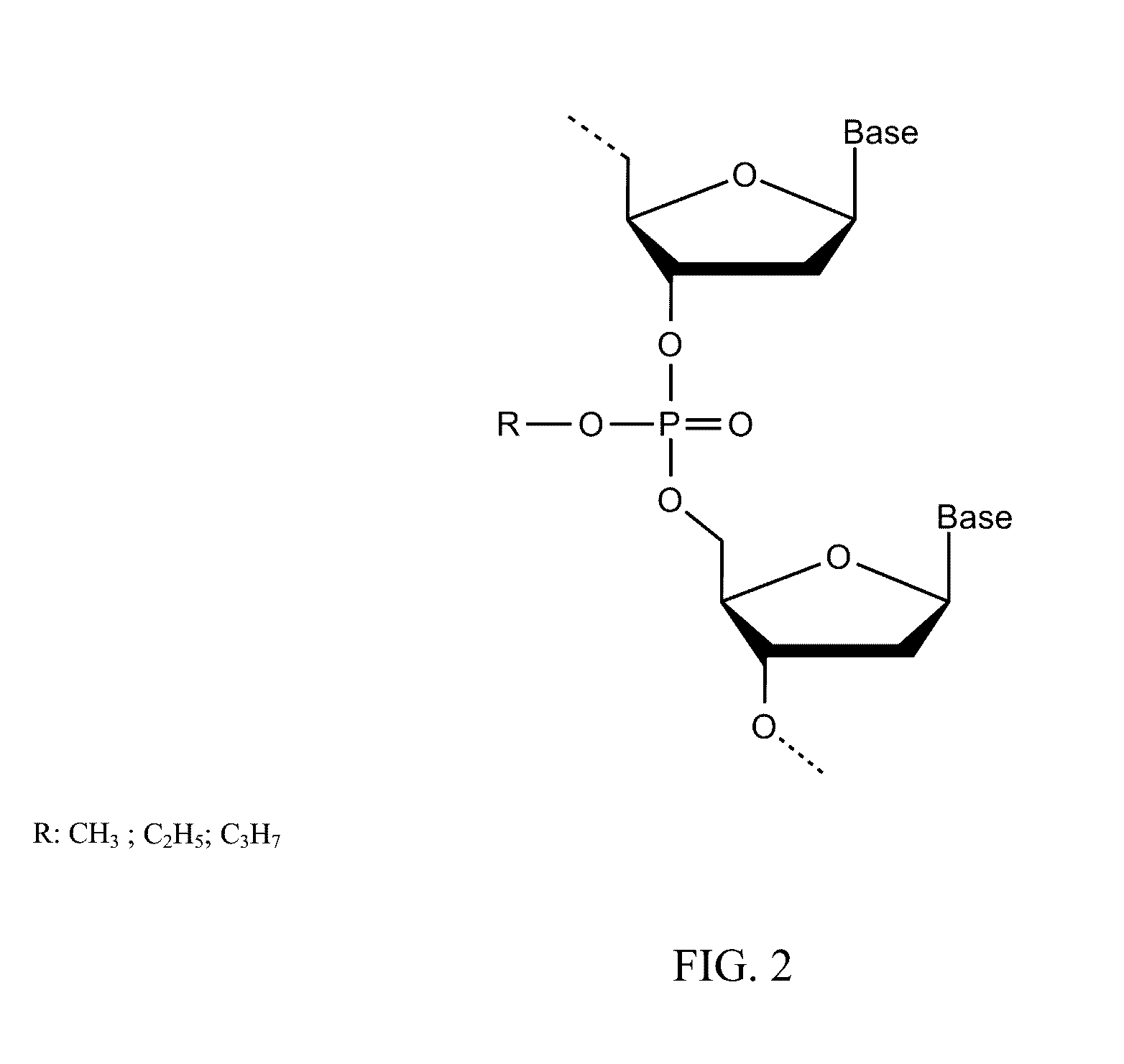DNA Methylation Detection
a methylation and methylation technology, applied in the field of molecular detection techniques, can solve the problems of unsatisfactory cost, unsatisfactory sensitivity and accuracy, and the microarray process fails to determine the number and position of 5-methylcytosine nucleotides, so as to improve the sensitivity and accuracy of dna methylation detection and achieve quick and convenient detection methods.
- Summary
- Abstract
- Description
- Claims
- Application Information
AI Technical Summary
Benefits of technology
Problems solved by technology
Method used
Image
Examples
example 1
Detecting the Position of the Methylation of the Target Oligonucleotide Molecule
[0090]The target oligonucleotide molecules were SEPT9 methyl DNA target 1 (C5), SEPT9 methyl DNA target 1 (C14), and SEPT9 methyl DNA target 1 (C26), having a methylated cytosine nucleotide at positions 5, 14, and 26, respectively.
[0091]The target oligonucleotide molecule was mixed with a bis-tris propane buffer at the concentration of 100 pM, and captured by SEPT9 DNA probe 1 attached to the SiNW for 30 minutes to form a duplex.
[0092]Anti-5mC antibody (0.25 μg / mL) as an electrically charged methylation detecting molecule was introduced to the duplex for reacting for 30 minutes.
[0093]The results are shown in FIGS. 3 to 7.
[0094]FIG. 3 shows the electrical signal of pSNWFET under analyte processing. “▪” line showed the Id-Vg curve of pSNWFET processed with 10 mM, pH=7 bis-tris propane buffer. After the pSNWFET processed with the complementary DNA, the DNA compromised buffer was replaced with the same bis-t...
example 2
Detecting the Number of the Methylated Cytosine Nucleotides in the Target Oligonucleotide Molecule
[0096]The target oligonucleotide molecules were SEPT9 methyl DNA target 4 (C2), SEPT9 methyl DNA target 5 (C2+C16), and SEPT9 methyl DNA target 6 (C2+C16+C32), having one, two or three methylated cytosine nucleotides, respectively.
[0097]The target oligonucleotide molecule was mixed with a bis-tris propane buffer at the concentration of 100 pM, and captured by SEPT9 DNA probe 1 attached to the SiNW for 30 minutes to form a duplex.
[0098]Anti-5mC antibody (0.25 μg / mL) as an electrically charged methylation detecting molecule was introduced to the duplex for reacting for 30 minutes.
[0099]The results are shown in FIGS. 8 to 10.
[0100]The target oligonucleotide molecules were synthesized with different numbers of methylcytosine, which provides different numbers of antibody binding sites. FIG. 8 shows the detection result of SEPT9 methyl DNA target 6. As the validation of distance effect, Id-Vg...
example 3
Detecting the Methylated Cytosine Nucleotides on a Single Strand Tail in the is Target Oligonucleotide Molecule
[0101]The target oligonucleotide molecule was SEPT9 methyl DNA target 7 (C39).
[0102]The target oligonucleotide molecule was mixed with a bis-tris propane buffer at the concentration of 100 pM, and captured by SEPT9 DNA probe 2 attached to the SiNW for 30 minutes to form a duplex.
[0103]Anti-5mC antibody (1 ng / mL) as an electrically charged methylation detecting molecule was introduced to the duplex for reacting for 30 minutes.
[0104]The results are shown in FIG. 11. The figure demonstrates that the methylated cytosine positioned on a single strand tail of the duplex formed by the SEPT9 DNA probe 2 with SEPT9 methyl DNA target 7 increases the detection limit to 1 ng / ml anti-methylcytosine antibody.
PUM
| Property | Measurement | Unit |
|---|---|---|
| Fraction | aaaaa | aaaaa |
| Length | aaaaa | aaaaa |
| Electric potential / voltage | aaaaa | aaaaa |
Abstract
Description
Claims
Application Information
 Login to View More
Login to View More - R&D
- Intellectual Property
- Life Sciences
- Materials
- Tech Scout
- Unparalleled Data Quality
- Higher Quality Content
- 60% Fewer Hallucinations
Browse by: Latest US Patents, China's latest patents, Technical Efficacy Thesaurus, Application Domain, Technology Topic, Popular Technical Reports.
© 2025 PatSnap. All rights reserved.Legal|Privacy policy|Modern Slavery Act Transparency Statement|Sitemap|About US| Contact US: help@patsnap.com



